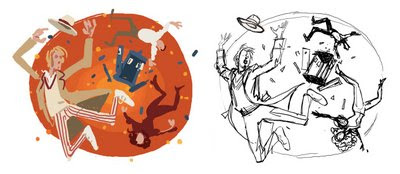
The Fianna from The High Deeds of Finn MacCool illustrated by Michael Charlton 1967
Mike Charlton is one of my favourite artists, he was also my friend, my best mate's Grandfather, my landlord for six years and (as he was fond of telling me) my mentor. For the sake of this blog I'm going to focus on Mike the artist, because you don't need to have loved him as a man to love his art. He's not as well known as some of his contemporaries and given how modest and unpretentious he was about his art that isn't surprising, but other artists really should look at his work.
I'll hopefully write more about Mike's work in the future, for now though I've scanned some of his work from The High Deeds of Finn MacCool - I have two originals from this book in my collection so you can compare the printed image with the drawn image. And this book features some of his best work - work that reflects his personal vision.

Finn and Niamh
There were a number of illustrators producing beautiful free line illustrations in books during the 1960s. Freed from the constraints of hatching madly away in an attempt at 'realistic representation' illustrators took to using more abstract approaches. And it wasn't just children's books that had illustrations in the 60s, the inky textures of the illustrations sat happily on the same plate as the type and it seemed perfectly natural for the text to catch its breath every once in a while as the illustrator took over. There's an art though to filling those spaces in the text, perfectly exemplified by Mike's illustrations in Rosemary Sutcliff's High Deeds. In fact these illustrations are even making my blog look rather lovely!

The Hounds from the High Deeds of Finn MacCool
The art to filling those spaces is to illuminate the text without casting a shadow over it, to illustrate what's happening without distracting the reader with your personal vision. This is where Mike's modesty and lack of pretension give him an edge in my view. His illustration tends to be sympathetic to the text and to the page, never looking to compete for attention. He doesn't have Victor Ambrus's quirky characters or Charles Keeping's bold experimentation and perhaps it's for this reason his work didn't garner more attention and praise. It doesn't jump up and down demanding attention.

The Battle of Gavra
In the Battle of Gavra image you can see Mike soaking up the influence of stablemate Charles Keeping. He's trying out some of those forced almost geometric shapes that underpin Keeping's style. He's also sculpting the ink splashes with brush and pen. It's totally sympathetic to the subject matter and it's probably no coincidence that Keeping himself found his identity illustrating Rosemary Sutcliff (1957's The Silver Branch). It was great subject matter for artists of that generation who themselves were raised on tales of high adventure and derring-do.

Finn battles the Aillen of the Flaming Breath
In the Aillen picture though you can see Mike's natural figure drawing ability breaking through. I can honestly say that I don't think I've seen anyone with more natural drawing ability than Mike, it shines through even when he's trying to obscure it or uglyfy it. Mike may not have had some of the stylish quirks or experimental tendencies of some of his contemporaries (I think he secretly thought such things were just showing off and not for him), but those contemporaries could only look on with envy at his gift for drawing.
Mike once told me that his vision - his idea of the perfect illustration - would be a single line that looked so natural, so unforced, that it could just as easily be a spill from an ink bottle or a stream of smoke. But within that line he imagined an entire army laying siege to a craggy castle. It would be an image so unassuming that it concealed its beauty by appearing to be an accidental blemish. And yet when the viewer chose to focus on it they could discern all the information: the battered helmets, chipped swords, split shields, rocks, crumbling walls and all the emotion: the bleakness of the day, the striving of the army, the bucking of scared horses and the shouts of the men. It's a wonderful idea and it will remain stuck in my head forever.
It was in the early 90s that he told me about this vision and it was back in the late 60s that the vision came to him. Well, I happen to think that he came pretty close to that vision in this book and others from that period. He wasn't trying to show you how clever he was, he was trying to make illustration so incidental and natural that it belonged in the text. When I see editions of books like Finn MacCool, or Hiawatha without Mike's illustrations they look naked and incomplete. You can't pay an illustrator higher praise than that.

There's an obituary and list of published books
here at Bear Alley.













































![[huzzahnoir2.jpg]](https://blogger.googleusercontent.com/img/b/R29vZ2xl/AVvXsEhfLdDLBBPfTSXRPWrnWAtBD0aOZCN-zriqioFPJjPJkoxY_aiXqD070FccoLIdFOmwjNgUsYhjDfS9Rby_Ma7JXa-i5imDIl2Ytku1_gMjs3jRgRlOJMALTP_pDI6ovoek8_Uhz-zi7Eum/s1600/huzzahnoir2.jpg)